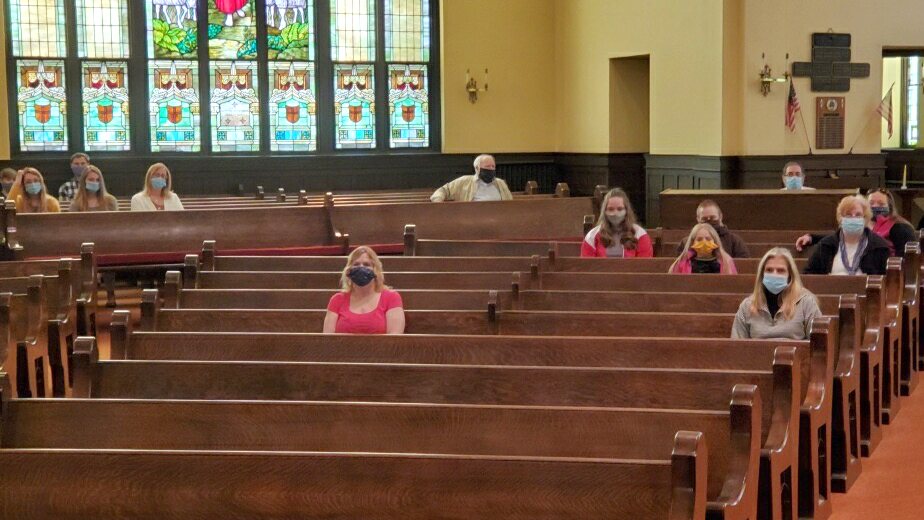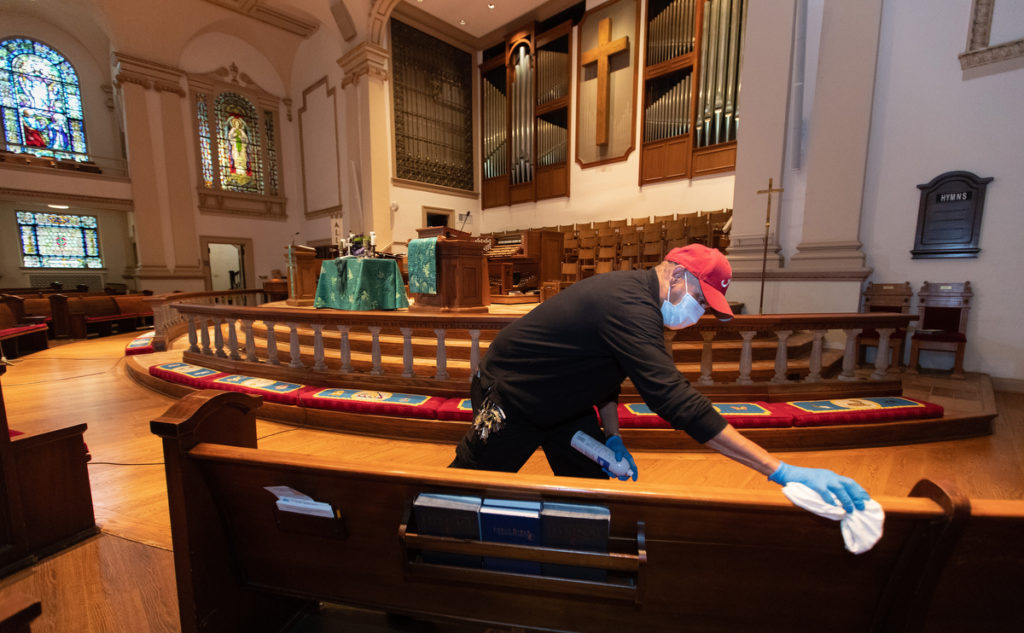
Re-opening Best Practices for Local Churches
Eastern PA Conference United Methodist Church
Updated November 2020
The Eastern PA Conference places the health and welfare of our members and the surrounding community as the first priority in making decisions around occupancy. As COVID numbers continue to rise, we recommend churches monitor their county numbers and modify their re-opening strategies and return to virtual offerings or decrease in capacity, as necessary. Congregations that reopen must be committed to the goal of flattening the virus by following all state & city guidelines and have a reopening plan approved by their church council. Please continue to monitor both the PA.gov and the CDC website for up-to-date information.
Overall Recommendations:
- Wear masks in public.
- Keep physical distance of six feet or more.
- Wash hands frequently for at least 20 seconds.
- Clean and disinfect surfaces often.
- Limit group gatherings and crowds.

Worship Recommendations:
- If moving to in-person worship, have a plan for managing the number of people per service. Please review the maximum occupancy calculator below.*** Have a plan to clean surfaces between services.
- Wear face masks while at church, as is recommended in public spaces. Please have masks available for people upon entry if they do not arrive with one. Have a designated leadership team prepared with a strategy to implement these recommendations. Do not let the burden of this implementation fall on the Pastor.
- Social Distance: Maintaining 6 feet between each person/family unit: See CDC Guidelines Distancing: Have people spread out in sanctuary space with one family unit per pew; keep empty pews between families. Mark off chairs for individuals/families with space between (use an X to cover chairs or pews that should not be used). Explore meeting in a fellowship hall or outdoors if your space is small.
- Singing: We know that singing is a meaningful part of our worship as United Methodists. As we put the health and welfare of our congregants and communities as our first priority, we continue to discourage congregational singing, especially in high-risk, vulnerable populations. One soloist, distanced from the congregation, is preferred over a choir. For those churches with choirs that plan to offer anthems, we recommend having choir members sign up to sing in small ensembles of three to four people where choir harmonies can be sung without having the full group. Social distancing between members of the ensemble and the wider congregation should be followed. Churches with a choir need to space members at least 6 feet apart, wear masks and sanitize hymnals and folders after each use. When it comes to congregational singing: Humming quietly with masks on is a better option than singing. Using bells or other instruments is a preferred option to singing, especially in high-risk, vulnerable populations. Reading the words of a hymn is also a possibility
- Human Contact: Preventing people from touching objects and people. See CDC GuidelinesUse no-touch alternatives for passing the peace, collecting offering, and liturgical resources. We recommend screens over bulletins. If you must use bulletins, do not reuse.
- Cleaning: Cleaning surfaces and all common areas: See CDC Guidelines.
- Vulnerable People: Taking extra precautions with older people, people with asthma, liver disease, hypertension, health conditions and disabilities: See CDC Guidelines
- Offering Communion safely will continue to be a challenge, as touching a face mask (to remove or shift it) contaminates it. Pre-packaged, sanitized communion packets may be the best option.
- We recommend against offering a fellowship/coffee hour. Continue encouraging people to leave the building rather than mingling. Separate exits or staggered worship times may be needed if simultaneous worship is in process.
- Bible studies and small groups can meet in person, following distancing guidelines and wearing masks. We recommend maintaining some online options for high risk individuals and those who do not feel comfortable being in public.
- Office functions could resume as normal, with attention to cleaning.
- Groups, teams, and committees can meet in person, wearing masks and following social distancing protocols.
- General Building:
- Post signs indicating symptoms and urging people to stay home/seek medical attention if they have symptoms.
- Maintain a good stock of tissue, soap, hand sanitizer and disposable paper towels for drying hands.
- Clean the building regularly and between user groups, paying extra attention to hightouch surfaces.
- If you become aware of someone in the church or a building user infected with COVID-19, put your communication plan into action, and cooperate fully with contact tracers.
***Pennsylvania Maximum Occupancy Calculator:
i. Maximum Occupancy Calculator for indoor events:
| Maximum Occupancy | Allowable Indoor Rate |
| 0-2,000 people | 20% of Maximum Occupancy |
| 2,001 – 10,000 people | 15% of Maximum Occupancy |
| Over 10,000 people | 10% of Maximum Occupancy up to 3,750 people |
ii. Maximum Occupancy Calculator for outdoor events:
| Maximum Occupancy | Allowable Outdoor Rate |
| 0-2,000 people | 25% of Maximum Occupancy |
| 2,001 – 10,000 people | 20% of Maximum Occupancy |
| Over 10,000 people | 15% of Maximum Occupancy up to 7,500 people |
Venues must require attendees to comply with 6-foot social distancing requirements, to wear masks or face coverings in compliance with my Order of the Secretary of the Pennsylvania Department of Health Requiring Universal Face Coverings, and implement best practices such as timed entry, multiple entry and exit points, multiple restrooms and hygiene stations. Venues and event planners can review the CDC Events and Gatherings Readiness and Planning ToolOpens In A New Window for additional information regarding best practices.
This Amendment is effective October 9, 2020, and enforcement of the Amended Order will commence on October 9, 2020.
Please note additional guidance for the city of Philadelphia: https://www.phila.gov/programs/coronavirus-disease-2019-covid-19/
